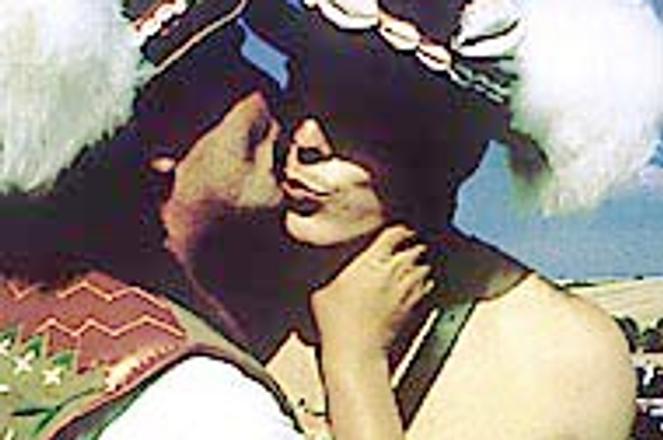Photographer Martin Marenčin takes an ironic look at folk celebrations in the series "Slowly Slovakia".photo: Martin Marenčin
"Pictorial documentation in this country is in deep stagnation," says photographer Ľubomír Groch. "There are few photographers who can fully devote themselves to this. And too few of them take pictures of the modern, current period of the country."
To correct the problem, and pictorially cover the country as it experienced dynamic changes after the fall of the Berlin Wall, a group of photographers decided to form a civic organisation called the Slovak Documentary Photography (SDF) in November 2000.
Its aim is to collect and present contemporary documentary works and bring them to the public. It also focuses on gathering funds to enable photographers to fully commit to long-term projects that will map over time the country's lasting events.
"We are persuaded that this unfortunate state of affairs is not caused by photographers' inability to create good works but rather the opposite - the absence of conditions for systematic documentary work," agreed the SDF's eight members, including well-known photographers such as Andrej Bán, Alan Hyža and Martin Marenčin.
Over the last year, the organisation asked more than 100 photographers to submit works charting the changes Slovakia went through between the collapse of communism in 1989 and today. The result was a collection of 100 photographs taken by 34 photographers, now being exhibited in Bratislava. A large volume collecting 170 reproductions by 41 photographers will soon be available at bookstores across the country.
The photographic collection was curated by Colin Jacobson from Britain. The SDF turned to him for two reasons: he was an independent authority with a impartial viewpoint, and he had valuable skills in the field. Jacobson used to work as picture editor for the English daily newspaper The Independent and the magazine Reportage, and twice served as head of the World Press Photo jury.
A flier for the exhibition.photo: Courtesy SDF
The Rodinný album.sk (Family Album), as the show is known, documents the mass demonstrations, strikes and political meetings that characterised the young country's turbulent infancy. There is Vladimír Mečiar pictured on a balcony behind a couple of giant hands clapping after the sovereignty of the country was declared in 1992. The hair of the first Slovak president, Michal Kováč, is captured standing like a cat's hackles in the wind during his meeting with Austrian President Thomas Klestil in 1993.
However, the majority of the photographs portray older people, the harshness of rural life, disappearing village traditions and factories in devastating surroundings. Alan Hyža presents a dying village next to an aluminium smelter. As the factory polluted the environment, people moved away, leaving only the village's church and cemetery. Andrej Bán's black and white photographs feature rituals and the lives of ordinary people in a style often labelled as depressing.
While the themes captured in the photographs do reflect the period the country is enduring, they are also evidence of what Slovak photographers understand by the term 'documentary photography' - something that offers comment on how the present is different from the past. The feeling of Slovak photographers that such photography can only be done as part of a long-term project was also disputed by Jacobson, and discouraged younger talents from submitting their work.
"Traditions in this field play a large role," said Martin Marenčin, the SDF's chairman. "Many photographers are influenced by the work of leading documentary photographer Martin Martinček, whose photographs depict older people and the world that is disappearing with them."
Restricted choice, old world themes and vastly different ideas about what the exhibition and book projects should achieve exploded into a sharp exchange of views between the organisation's members and the outsider Jacobson.
"We had a big argument with Jacobson over how he and we defined a documentary photograph, and over our plans for the project," said Ľubomír Groch, the SDF's deputy chairman.
In a picture titled Bratislava 2000, photographer Balco sees life as it is.photo: Andrej Balco
According to Jacobson, a documentary photo is anything that is interesting, even if created in a short time. "I can't offer any definitive conclusions except to suggest that documentary work, photography, reportage, news, photojournalism and more though-out social projects, all accept the possibility of a common shared experience of what we call the outside world."
The group's initial idea to create a project mapping a group of Slovak photographers and the themes they capture was also revised by Jacobson.
"His idea was to create a book that would tell a story from beginning to end," said Marenčin. "He refused our original idea as being too archaic, no longer used where he comes from. He wanted to make it more dynamic and lively."
Jacobson ended up including photographs the organisation did not agree with, and rejecting photographs from renowned artists because they did not obey his vision. And while for Jacobson it was a "rewarding and illuminating experience, helping me to understand the aspects of this country", he has left a permanent mark on Slovak documentary photography.
"He certainly changed my viewpoint," said Groch, who says he now realises how little Slovakia is open to the outside influences.
"Before his visit, I wouldn't have thought that some of the photos he chose could be perceived as documentary photos."
What: Rodinný album.sk - documentary photography exhibition
Where: Umelecká beseda (Art Centre), Dostojevského rad 2.
When: until February 3, open daily (except Mondays) 13:00 - 18:00
Admission: free.
Tel: 02/6280-1474.
The exhibition will then move to Dolný Kubín, Nitra and Banská Bystrica. For more information on Slovak Documentary Photography go to www.photodocument.sk


